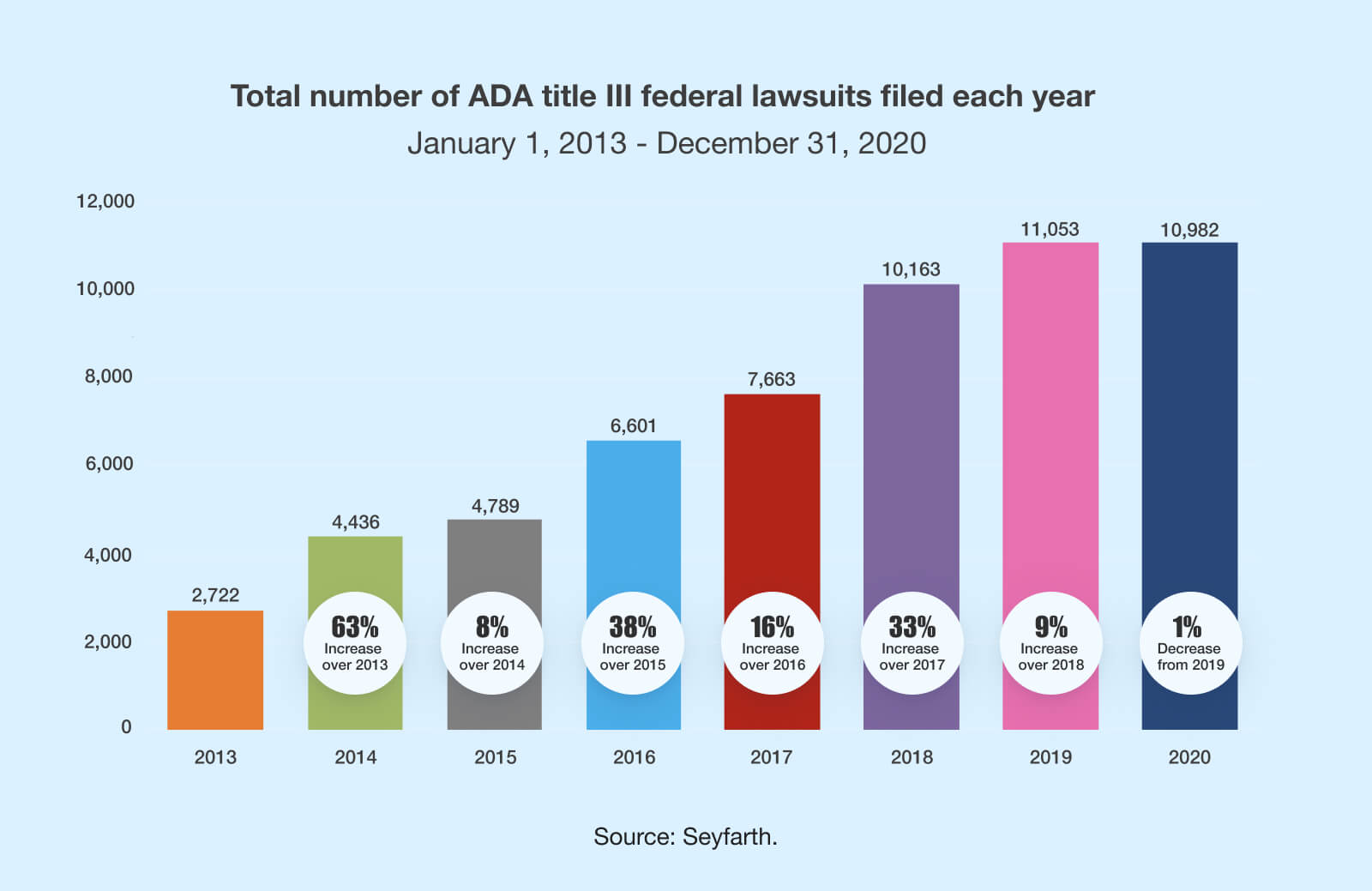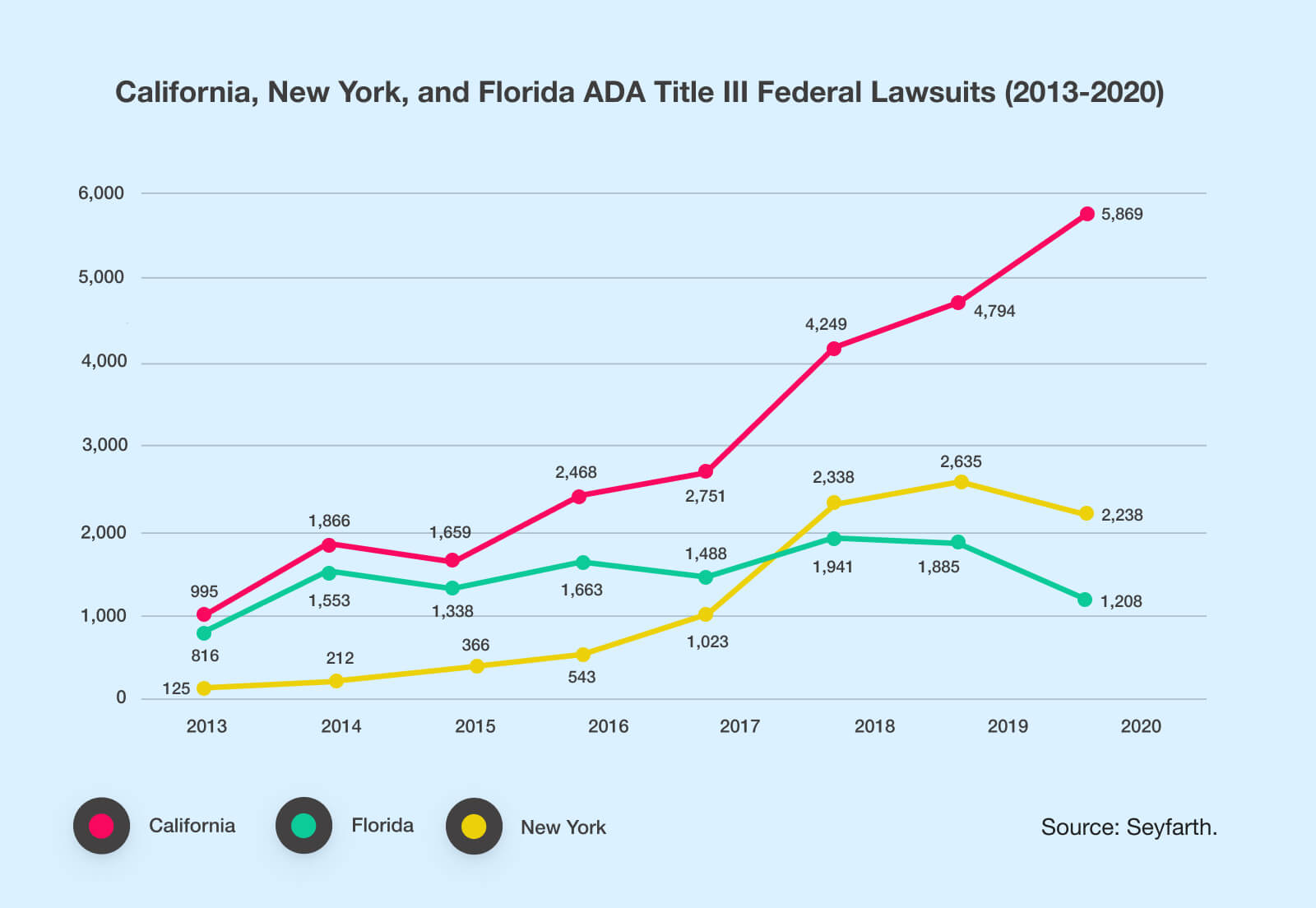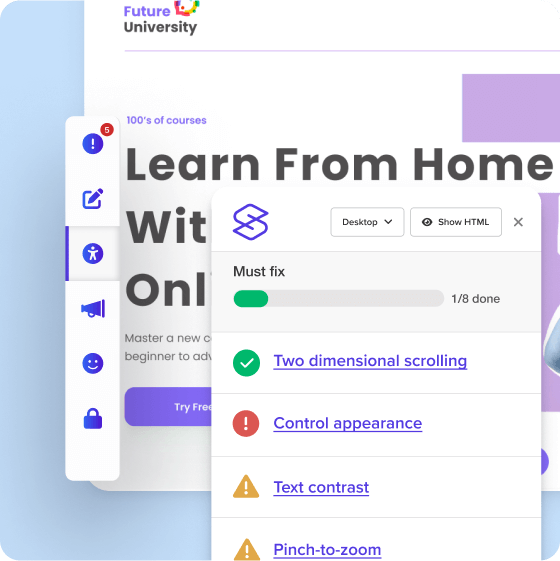New York’s commitment to digital accessibility is reinforced through existing federal legislation and local laws that have implications for web accessibility.
There are some key differences between these laws, especially when it comes to websites.
- Americans with Disabilities Act (ADA)
- Section 508 of the Rehabilitation Act of 1973
- New York State Human Rights Law (NYSHRL)
- New York City Human Rights Law (NYCHRL)
Recommendation for compliance
It is recommended that all New York websites should comply with WCAG 2.1 AA.
Law for public sector websites:
Americans with Disabilities Act (ADA) Title II
The ADA is a federal law that prohibits discrimination against people with disabilities in all areas of public life, including employment, education, transportation, state and local government services, and telecommunications. The ADA requires all public entities, including state and local governments, to make their websites accessible to people with disabilities.
Applies to:
- State agencies and government organizations
Requirements:
- Comply with Level AA of WCAG 2.0
Potential cost of violation
The ADA is a private right of action, meaning that individuals who have been discriminated against on the basis of disability can file lawsuits against the entities that have discriminated against them. This includes state agencies.
If the US Department Of Justice finds that a state agency has violated the ADA by failing to make its website accessible, it can bring a civil action against the agency and seek a civil penalty of up to $75,000 for an initial violation and $150,000 for subsequent violations.
The ADA does not specify any specific fines for non-compliance. However, individuals who successfully sue a business for violating the ADA may recover the following:
- Actual damages
- Punitive damages (no cap)
- Attorney’s fees (no cap)
Additional costs of ADA compliance may include:
- The cost of making their website accessible to people with disabilities
- The cost of expert witness fees and other litigation costs
- The cost of implementing anti-discrimination policies and training
Recommendations
- Ensure website compliance with WCAG 2.1 Level AA at a minimum
Section 508 of the Rehabilitation Act of 1973
Section 508 of the Rehabilitation Act of 1973 requires federal agencies and state governments that receive federal funding to make their electronic and information technology accessible to people with disabilities. This includes websites.
Applies to:
- All federal agencies and contractors
Requirements
- Comply with Level AA of WCAG 2.0
Potential cost of violation
There are no specific financial penalties for non-compliance with Section 508. However, the U.S. Access Board, which is responsible for enforcing Section 508, can take a number of actions against non-compliant agencies, including:
- Issuing technical assistance and guidance
- Conducting compliance reviews
- Mediating disputes between agencies and people with disabilities
- Referring cases to the U.S. Department of Justice (DOJ) for further action
Individuals cannot sue under Section 508. Section 508 is an enforcement tool for the U.S. Access Board and the DOJ. Individuals who believe that a federal agency or state government’s website is not accessible to them can file a complaint with the Access Board. The Access Board will then investigate the complaint and try to resolve the issue with the agency. If the Access Board is unable to resolve the issue, the Access Board may refer the case to the DOJ for further action.
The DOJ can also bring civil actions against non-compliant agencies. If the DOJ is successful, the court may order the agency to make its website accessible and to pay the DOJ’s costs and attorney’s fees.
However, the DOJ typically only brings civil actions against non-compliant agencies after the Access Board has tried to resolve the issue through other means.
Recommendations
- Ensure website compliance with WCAG 2.1 Level AA at a minimum
Law for private sector websites
Americans with Disabilities Act (ADA) Title III
ADA Title III mandates accessible public accommodations, including web accessibility for businesses and non-profits.
Applies to:
- Businesses and non-profits serving the public
Requirements
- Comply with Level AA of WCAG 2.0 or 2.1
Potential cost of violation
Violations can lead to lawsuits, with businesses potentially facing civil penalties, damages, and the costs of compliance and legal fees.
Recommendations
- Ensure website compliance with WCAG 2.1 Level AA at a minimum
Web accessibility lawsuits in New York
Prominent cases in New York illustrate the legal risks and the importance of web accessibility compliance:
Robles v. Domino’s Pizza, LLC
In a groundbreaking case, Robles v. Domino’s Pizza, LLC, Guillermo Robles, a blind user, filed a lawsuit against Domino’s for its website and app’s inaccessibility. The lawsuit, initiated in 2016, alleged that Domino’s digital platforms failed to accommodate screen readers, violating the Americans with Disabilities Act (ADA). Notable issues included the absence of alternative text for images and non-descriptive hyperlink texts. The Ninth Circuit Court of Appeals ruled that the ADA applies to websites and apps, setting a significant precedent. Although the Supreme Court declined to review the case, a settlement was reached in June 2022. While the settlement’s specifics were not disclosed, it marked a pivotal moment in ADA enforcement, emphasizing the necessity for digital accessibility.
Lawsuits Against the Five Boroughs of New York City
Several lawsuits have been filed against the websites of New York City’s boroughs, alleging failure to comply with web accessibility standards. These legal actions claim that the digital services provided by the boroughs are not fully accessible to visually impaired users, suggesting a breach of the Americans with Disabilities Act (ADA) and local New York laws. While specific cases and outcomes were not detailed in the sources, these lawsuits collectively underscore the legal and ethical mandate for public sector websites to ensure accessibility for all users, aligning with ADA and WCAG guidelines.
Williams v. Tennessee Wholesale Nursery, LLC
In February 2021, a lawsuit was filed against Tennessee Wholesale Nursery, LLC alleging the company’s website was not accessible to people with disabilities, in violation of the Americans with Disabilities Act (ADA), the New York State Human Rights Law (NYSHRL), and the New York City Human Rights Law (NYCHRL). The lawsuit claimed the website failed to meet WCAG 2.0 standards, citing issues like missing alternative text for images, empty and redundant links, and broken links preventing effective navigation by visually impaired users.
Fischler v. Two Nine Sports, Inc.
In December 2020, Brian Fischler brought a case against Two Nine Sports, Inc., the owner of the Stat Hero website, under the ADA, NYSHRL, and NYCHRL for not adhering to WCAG 2.1 accessibility standards. The complaint highlighted multiple accessibility barriers, including the lack of alt text for images, the use of duplicate IDs that confuse screen readers, and the absence of proper table headers, which collectively hampered the website’s usability for people with visual impairments.
Web accessibility lawsuit trends
Overall, the number of ADA Title III federal lawsuits filed each year is steadily increasing, from 2,722 in 2013 to 10,982 by 2020.

In New York, the number of ADA Title III federal lawsuits rose from 125 in 2013 to 2,238 in 2020.

Next steps
Getting started with web accessibility can seem overwhelming, but Silktide has the tools and experience to help you understand and comply with New York State and Federal accessibility legislation.
We combine powerful automated web accessibility testing with in-depth expert manual auditing by trained accessibility professionals.
Learn more about Silktide’s range of accessibility services.
Check your accessibility now with our free browser extension

